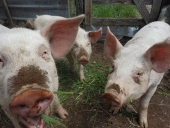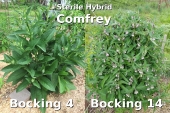
 9
9










 1
1




Tip: If you're trying to propagate new roots, one awesome way to do it is put a comfrey plant in a milk crate container, set it on the ground until the plant is established, then pull it off the ground, leaving lots of new little roots in the row.
Argue for your limitations and they are yours forever.




Mike Barkley wrote:
Tip: If you're trying to propagate new roots, one awesome way to do it is put a comfrey plant in a milk crate container, set it on the ground until the plant is established, then pull it off the ground, leaving lots of new little roots in the row.
Thanks for that excellent idea.
 2
2




Argue for your limitations and they are yours forever.
 11
11




"The rule of no realm is mine. But all worthy things that are in peril as the world now stands, these are my care. And for my part, I shall not wholly fail in my task if anything that passes through this night can still grow fairer or bear fruit and flower again in days to come. For I too am a steward. Did you not know?" Gandolf








 1
1




Argue for your limitations and they are yours forever.




 1
1




Derrick, i have tons. could dig and send you a root if you want one?Derrick Clausen wrote:Unfortunately I did manage to kill my bocking #14 comfrey. Was doing really good potted after removing from ground when I moved. Put it in the ground here at our new place not realizing yet that the area was gonna be flooded by rain a week later. It root rotted fairly quickly and I was very sad to loose it. It was something we use regularly as a topical healing agent.




 2
2




 7
7




A build too cool to miss:Mike's GreenhouseA great example:Joseph's Garden
All the soil info you'll ever need:
Redhawk's excellent soil-building series





 1
1




 1
1




 3
3




Tara Ba wrote:What is the best way to start growing comfrey? Buy a plant or seed?
A build too cool to miss:Mike's GreenhouseA great example:Joseph's Garden
All the soil info you'll ever need:
Redhawk's excellent soil-building series





 2
2




youre welcome! in your enviroment put them in some afternoon shade. they should do well for you.Derrick Clausen wrote:Thank you Steve for the roots/crowns! They came yesterday and will be planted today. Been contemplating where to place them. Definitely very awesome of you!
 2
2




PSST. Hey dude, want some status updates?
*opens trench coat*
www.alexisrichard.com
 1
1








root cuttings work best. this hybrid comfrey has sterile seeds.Tara Ba wrote:What is the best way to start growing comfrey? Buy a plant or seed?
 1
1




steve bossie wrote:watch out Alexis! comfrey planting is highly addicting! once you have a few , then you want to cover the world in comfrey! ;) contact me in mid may and ill dig and send you some root cuttings. you should be able to harvest the leaves years round in your climate. i would plant in 12in. mounds to help in drainage so your cuttings don't rot. some afternoon shade will be needed because above 90f they will wilt and stop growing.
PSST. Hey dude, want some status updates?
*opens trench coat*
www.alexisrichard.com




 3
3




Argue for your limitations and they are yours forever.
 1
1
















its a cold weather plant. the colder it is the tougher and better it grows. probably heat that weaken it. it is the 1st plant growing out of the snow herein the spring and the last one growing as the snow falls in early winter. i have heavy rocky clay soil that kills fruit trees if i plant directly in it. comfrey grows right through that and thrives in it. one spot in my yard is under water for 3 weeks in the spring. as the water starts to come down the comfrey there starts to put out leaves. its one tough plant if grown in the right climate.Ben Waimata wrote:I think some caution is necessary with the comfrey enthusiasm. I planted masses of the recommended strain under citrus and avocado trees for a self-perpetuating living mulch/fert source. Sounded like a good idea at the time. 10 years on it is all gone, just died away. I dug some up to see the amazing root system, it went down about 3 inches with a few wispy roots down a foot or two. I dug some out with the excavator, shallow roots, and nothing down deep. This is not a soil issue, even notoriously shallow rooted perennial ryegrass and white clover where rooting much deeper in the same soil. I used it in liquid and found the results less than fantastic, much better growth came from using Albizia tree leaf tea for example. Basically I found the hype totally out of proportion to the reality; yes it is a useful permaculture plant, but nothing like the wonder plant it is claimed to be.
 2
2




Creating edible biodiversity and embracing everlasting abundance.
 3
3




A build too cool to miss:Mike's GreenhouseA great example:Joseph's Garden
All the soil info you'll ever need:
Redhawk's excellent soil-building series





 3
3




 |  |
 |  |




. . . bathes in wood chips . . .
 1
1




Kevin Vernoy wrote:I'm trying to figure out which Bocking strain of comfrey I have. People have been saying that I might have Bocking 4 because their Bocking 14 strain has blue-tinged flowers from time to time and mine do not. Any ideas? These are pics of my comfrey:






 2
2




Other people may reject you but if you lie in the forest floor for long enough the moss and fungi will accept you as one of their own!





|
Even monkeys fall from trees. I brought you an ice pack tiny ad.
Homestead Pigs Course
https://permies.com/wiki/365748/Homestead-Pigs
|

